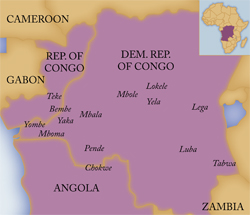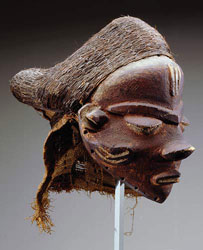

 peoples of today, including the Yombe, Mboma, and Bembe, were part of the Kongo kingdom that existed when the Portuguese first arrived at the end of the fifteenth century.
peoples of today, including the Yombe, Mboma, and Bembe, were part of the Kongo kingdom that existed when the Portuguese first arrived at the end of the fifteenth century.  Symbols of a chief's power, such as carved ivory scepters and finials for staffs, were, and still are, among the most important works of art in the Kongo region.
Symbols of a chief's power, such as carved ivory scepters and finials for staffs, were, and still are, among the most important works of art in the Kongo region. Among the Luba and Chokwe peoples, figurative stools symbolize a chief's authority. While the stools function as thrones, and are sat upon sometimes, they have a more important role as spiritual seats of authority and metaphoric resting places.
Much of the art of the Lega people, who have no kings or tribal chiefs, is used in association with the Bwami society, a closed society that unites the members of Lega communities. Highly stylized figurative ivory carvings, the property of Bwami members who had attained the association's highest rank, were used in Bwami rituals, sometimes arranged in configurations or held during dancing.



